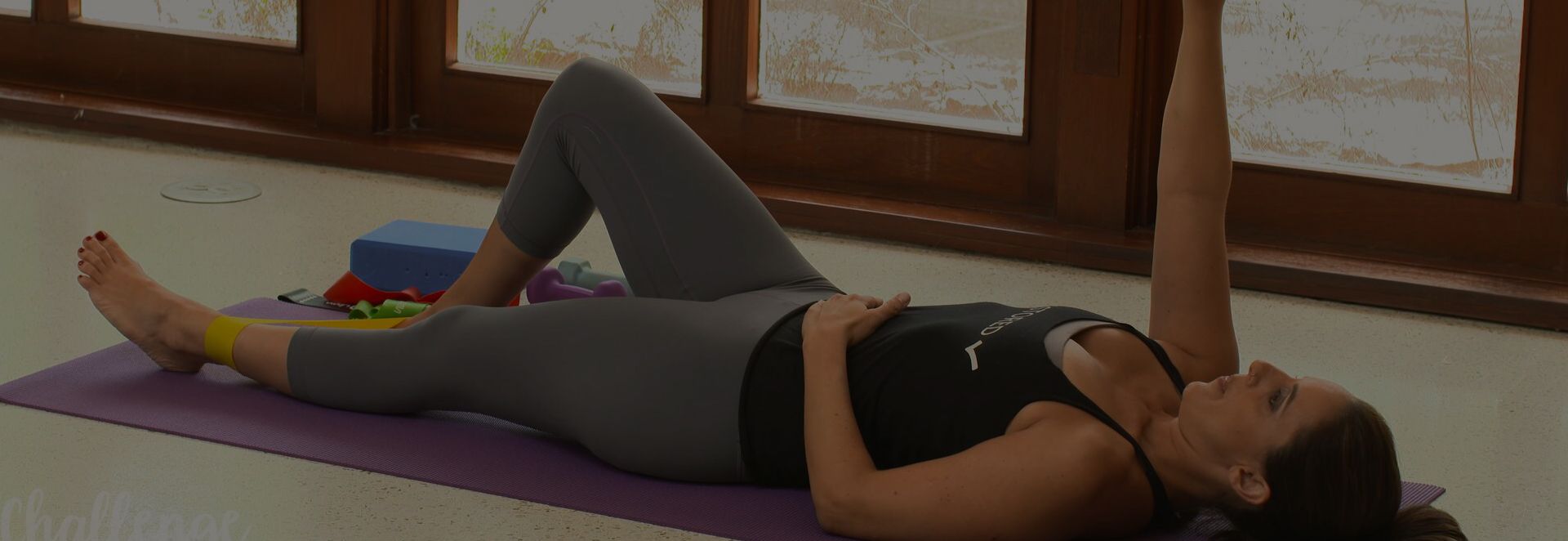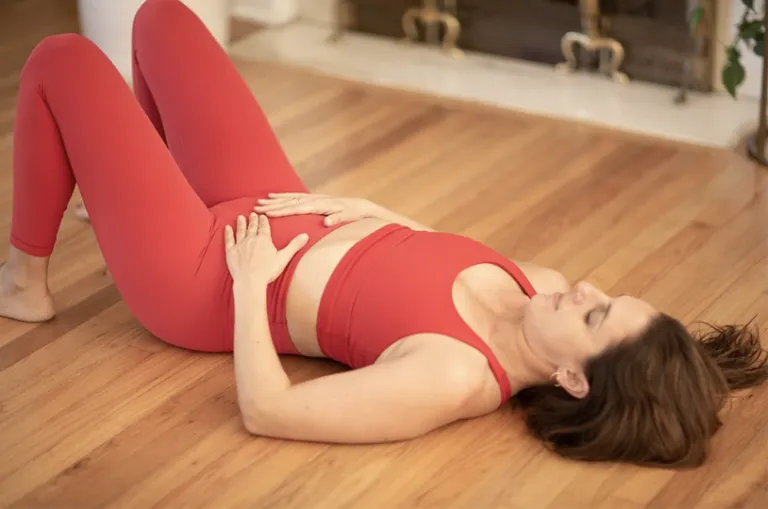Effective Exercises for Relief and Recovery from Prolapsed Uterus
6 Min Read
Looking for comprehensive guidance on safe and effective exercises designed for the relief and recovery of a prolapsed uterus? Look no further. Learn about what is safe to do with a prolapsed uterus, and find practical solutions that will help you begin your recovery.

Table of Contents
What is Uterine Prolapse?
Uterine prolapse is a condition in which the uterus has become displaced, usually due to weakened pelvic floor tissues, and has “slipped” into the vaginal canal. It is one of several types of pelvic organ prolapse (see more here). It often feels like a tampon falling out of the vagina, and sometimes, the uterus may even bulge out of the vaginal entrance. Other symptoms may include:
- A heavy pulling or dragging sensation in the pelvic floor
- Pain or discomfort during intercourse
- Difficulty with urination, including incomplete bladder emptying or urine leakage
- Constipation
- Back pain
The treatment options for a prolapsed uterus are varied: physical therapy, corrective exercises, and surgery are all options depending on the severity of the prolapse and how much it affects your everyday life. Whether or not you ultimately decide to pursue surgery, exercise is beneficial for prolapse. Exercises that benefit your pelvic floor and core will help you develop movement patterns that support your healing and help relieve the symptoms of uterine prolapse.
Common causes of a prolapsed uterus
Uterine prolapse has several possible causes, but in general it is caused by a weakening of the pelvic floor muscles and the ligaments holding the uterus in place. This can be attributed to:
- Pregnancy or
- Lifting loads that exceed the body’s capacity to manage them
- Vaginal delivery, especially with a difficult labor or birth trauma
- Chronic constipation or straining with bowel movements
- High body weight
- Loss of estrogen after menopause
Aside from the loss of estrogen, most of these causes can be linked to the core and pelvic floor experiencing loads exceeding what it is capable of managing. In cases of labor and delivery issues, these loads are often unpredictable, or may involve extended periods of pushing, which very few pelvic floors can handle without trouble. Whatever the cause of your particular prolapse, you are far from alone. And you have options for healing.
Can I exercise with a prolapsed uterus? Yes, you can!
Exercise can be a huge help in relieving the symptoms of a prolapsed uterus. You may need to adapt some exercises to suit your body’s needs, but you can absolutely get stronger and feel better with prolapse. Of course, you should check in with your health care provider before beginning an exercise program like Restore Your Core®.
When you begin rehab exercises for a uterine prolapse, you may worry that you’re going to make the prolapse worse. Here’s how to avoid making it worse:
- Do not bear down when performing exercises
- Use caution when increasing the loads you’re using
- Be mindful about what sensations you’re noticing during exercise–err on the side of doing less rather than more until you really know your limits.
All that being said, there are many safe exercises for a prolapsed uterus that you can perform, and practicing them can provide some relief from your symptoms. The goal with these prolapsed uterus exercises is to build your body’s capacity to move better, so you can feel better. Even if your prolapse is severe enough to warrant surgery, learning solid movement strategies will help you prepare and recover. Being able to move better means you’ll be able to engage in your daily life with more pleasure and joy.
Exercises for Prolapsed Uterus
Here are a few exercises to help a prolapsed uterus. These exercises will help you connect to your pelvic floor and find some relief from your symptoms. Ideally, these exercises would be part of a regular movement practice, and performed 3-5 times per week. You might find that you prefer a comprehensive program like Restore Your Core®, which includes many safe exercises for prolapse uterus. Or you might prefer to use them as a warm-up before taking a walk. Another way to work them into your daily routine is to just pick two or three to do each day and do them first thing in the morning, or as breaks during a workday.
Three essential exercises
Practice breathing with a three-dimensional breathing pattern (see this video for why and clear a practice to follow along with): One of the best exercises for prolapsed uterus is learning how to breathe better. If you don’t have time to watch the video:
- Sit comfortably with weight on sitbones
- Place hands or yoga strap on ribcage
- Inhale, moving hands apart
- Exhale effortlessly
- Repeat 5-10 times
- Feel ribs expand on inhale
- Avoid excessive pelvic floor pressure
The next two exercises can be done in any order–you might find that it feels better to do the psoas release at the end of your day, rather than right before you do a bunch of bridges.
Psoas release with a block under pelvis:
- Lie on your back with feet flat and knees bent
- Place a block or bolster under your pelvis
- Make sure your pelvis feels supported, and there is space between your low back and the floor.
- Let your arms relax by your sides
- Rest here for 5-10 minutes
- Slowly slide the block out and rest on the floor briefly.
Bridges (with variations):
- Lie on your back with knees bent and feet flat, pelvis-width apart
- Press down through your feet to lift your pelvis away from the floor and hold
- Slowly lower down
- Repeat several times.
Variation 1:
- Step one foot out to the side of your mat (how wide is up to you!)
- Repeat the exercise and notice how your glutes may activate more on that side
- Perform 3-5 times per side
Variation 2:
- Press your feet into the floor to raise your pelvis
- Allow one hip to sink down a bit toward the floor (but not all the way).
- Press through that foot to bring that side back up
- Alternate sides, as if you’re “walking” your pelvis
Not quite a bridge, but variation 3: Instead of pressing your foot into the floor to raise your pelvis, let your foot steer your pelvis side to side.
- Press one foot down as if you’re going to lift off
- Instead, let the hip roll toward the other side, like you’re allowing a marble to roll from the ASIS (bone in front of the pelvis) on that side, over to the other side.
- Come back to the center and roll the marble from the other side
- Repeat 8-10 times
Three great exercises for when you have extra time
All fours knee on block listing:
- Come onto all fours with a yoga block under one knee
- Make sure that your spine is neutral, not rounded and not collapsed
- Exhale and press your knee into the block to bring both knees to the same height
- Hold for a moment or two
- Lower the knee to the floor
- Repeat the lift and lower 8-10 times.
- Switch sides.
Arm rotations: One of the frequently overlooked areas that plays a part in how well our pelvic floor functions is the upper body. But if your upper body is feeling tight and hunched over, you may have excessive pressure on your pelvic floor. These arm rotations are a simple way to start breaking up some of that tension.
- Come into a neutral standing or seated position
- Reach one arm away from the side of your body, palm facing up
- Imagine you’re holding a bowl of water in your hand
- Slowly pour the water out by rotating your shoulders forward
- Initiate the movement from the shoulder, not the wrist
- Pour out the water behind you by rotating your shoulder backward
- Keep the rest of your body still
- Repeat several times, then switch sides.
Butt slides: This simple hip hinging exercise is much harder than it sounds, and is a building block for more heavily-loaded moves such as squats and deadlifts.
- Stand with your butt against a wall with legs straight and your feet about pelvis-width apart
- Walk your feet approximately 12” away from the wall
- Hinge from the hip and let your sitbones slide up the wall
- Only go as far as you can without rounding your back
- When your butt stops sliding up the wall, stop moving
- Pause, then exhale to slide back to standing
- Repeat several times

The big picture of pelvic health and exercise
Taking a whole-body approach to pelvic health exercises, like we do in Restore Your Core®, is a strategy that supports your body through many life changes and the many different needs your body will have over time. Even with prolapse, it is possible to find ways to exercise that help you manage your symptoms and find more ease of movement. The key is to take a proactive approach rather than looking at just the organ that has prolapsed. The tissues of our body are not detached from each other: what we do with our shoulders and feet is just as important as what we do with our pelvic floors.
Lifestyle factors to keep in mind
Your body does best when it is well-nourished, hydrated, and rested. Reduce stress as much as possible, and seek mental health help when needed. Our bodies are great at adapting to the input we give them–so this means give your body varied movements, different kinds of loads, and plenty of changes in position throughout your day. Most of all, remember that healing takes time and isn’t linear. It may not look like what you think it should look like. You may need to consider options you hadn’t previously considered. But you can find relief from your symptoms, and you can find new ways to move that bring you joy.
FAQ
A prolapsed uterus is a uterus that has moved down from its proper position in the pelvis.
Some exercises can worsen the symptoms of a prolapsed uterus. Avoid exercises that put too much pressure on your pelvic floor or make you bear down as you move.
In general, 3-5 days per week is helpful during the healing process.
Be mindful of how you’re moving. Increase loads gradually and with attention to whether you’re defaulting to a movement strategy that is not ideal. Check in with your body often.
Yes, exercises for a prolapsed uterus help balance all the muscles of the pelvic floor, and therefore may help with incontinence issues.
Usually, you’ll begin to see some changes in about 2-3 months. It may take much longer, depending on how much time you have to be consistent with your exercises and how intense your symptoms are.




